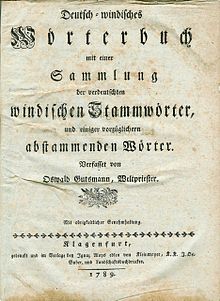Slovenian dialects
Slovenian dialects can be divided into seven groups. A special case outside of these categories is the Resianische . Since the Slovene language area seldom formed a political unit over the centuries and the various valleys or regions were isolated from each other by the mountainous topography, numerous very different, but also very original dialects developed. These can be summarized in seven groups.
The individual dialects
Upper Carniolan (Slov. Gorenjsko )
Lower Carniolan (Slov. Dolenjsko )
Primorsko
- In Primorska , the coastal country , there is a change from [g] to [h], especially in the region around the town of Nova Gorica .
Panonska Slovenščina
- Slovenskogoriško
- Prleško
- Prekmursko ( Prekmurje Slovene )
- Haloško
Rovtarsko
Styrian-Slovenian (Slov. Štajersko )
- This dialect is spoken in the Slovenian region of Štajerska ( Lower Styria , which was formerly part of the Crown Land of Styria) and in the bilingual localities of the Austrian state of Styria, but not in western Lower Styria, where the Carinthian Slovenian comes into play. It is characterized by the presence of the sound ü, which is unknown in the standard Slovenian language, e.g. B. "krüh" for "kruh" (bread). Where the suffix is stressed in the standard language , the stem is usually stressed in Styrian .
Resian
- Resianic deserves special attention, as it developed very peculiarly with the early breaking of linguistic bridges. Originally Carinthian, it was later based heavily on the coastal landscape before this bridge also broke. From the 19th century it developed its own literary language .
Carinthian Slovenian
The Carinthian dialect branch of Slovene (Slovene: Koroško ) extends beyond the current borders of Carinthia. It is spoken in the bilingual areas that belonged to the Duchy of Carinthia until 1918 (i.e., in addition to the current state, the upper Canal Valley around Tarvisio and the Mießen Valley ). In addition, the Carinthian-Slovenian dialect form is widespread in the Slovene Rateče ( German : Ratschach ), a village in the Upper Carniola (Gorenjska), and in the Lower Styrian Drau Valley . The Carinthian dialects are particularly original.
The dialects of the Carinthian Slovenes can be divided into:
- Jauntalerisch
- Jauntalerisch is characterized by the pure pronunciation of the palate sounds, often nasal treatment of the A-vowel and by the addition of an š in front of the demonstrative pronoun ( što, štu, šteka ), after these characteristics the inhabitants of these areas are also called Štekarji . The Obirmundart , which is influenced by Upper Carniolan , can be seen as a subgroup of Jauntal .
- Rosy throat
- Rosentalerisch is characterized by the frequent use of the semi-vowel, a far-reaching exchange of the E sound and a consequent assimilation of the vowel preceding the L in final syllables. Furthermore, the K between vowels is pronounced as a crack and at the beginning and end of a syllable as a zero sound.
- Gailtalerisch
- Gailtalerisch is characterized by a considerable number of archaisms.
In today's German-speaking areas, the Slavic subsoil can be identified by place and field names up to the upper Möll valley. In addition, the German and Slovenian dialects of Carinthia have influenced each other in sound and vocabulary over the centuries.
- Windisch
- → See also: Windisch theory
- The term Windisch ( Wendisch in northern Germany ) was originally used in German-speaking countries for all Slavic languages, and especially in southern Austria as the name for the Slovenian language. As a collective term for the Slovene dialects spoken in Carinthia, it is still used in part to this day (especially by German national circles). However, since this term is historically burdened, it is rejected by a large part of the Carinthian Slovenes. In the censuses, Windisch is listed as a separate language category alongside Slovenian.
Linguistic phenomena
Change from [g] to [h]
In many Slovene dialects, the replacement of the consonant [g] with [h] - not to be confused with [x], which is given in Slovene as "h" - is striking. The name "Gregor" is then z. B. pronounced as "hrehor". This phenomenon occurs in the coastal region (Primorsko), in Upper Carniola and in Carinthia.
This g / h change occurs more often in the Slavic languages and often differentiates the individual languages from one another (e.g. border is called hranice in Czech, granica in Croatian; city in Russian gorod, in Ukrainian horod).
Individual evidence
- ↑ PANONSKA NAREČJA ( page no longer available , search in web archives ) Info: The link was automatically marked as defective. Please check the link according to the instructions and then remove this notice. (Slovenian, accessed June 13, 2010)
- ^ Carl Pečnik: Practical textbook of the Slovenian language for self-teaching: Theoret.-Prakt. Appendix Hartleben Verlag, Vienna / Leipzig undated [1919], p. 106 ff. ( Entry of the sixth edition in the catalog of the German National Library )
- ↑ In 2014 the spoken Slovenian dialect from Radsberg, which is included in the dialect of the Klagenfurt field , was published in its current form in dialectal episodes and cheerful village stories by Tomaž Ogris in book form and on CD-ROM in the book Vamprat pa Hana . Tomaž Ogris: Vamprat pa Hana, Domislice, čenče, šale, laži . Klagenfurt / Celovec, Drava Verlag 2014, ISBN 978-3-85435-748-3 .
- ↑ Book cover: Archived copy ( Memento of the original from March 4, 2016 in the Internet Archive ) Info: The archive link was inserted automatically and has not yet been checked. Please check the original and archive link according to the instructions and then remove this notice.
Web links
- Slovenian dialects at www.arnes.si (accessed July 10, 2009)
- A map of the Slovenian dialects , PDF (accessed June 12, 2010)
